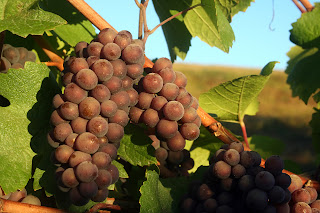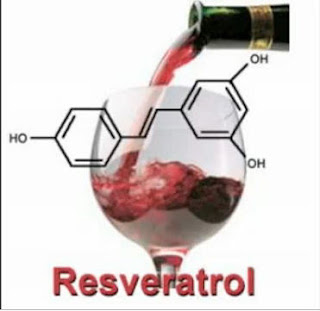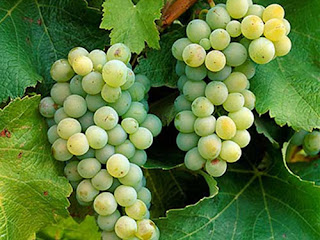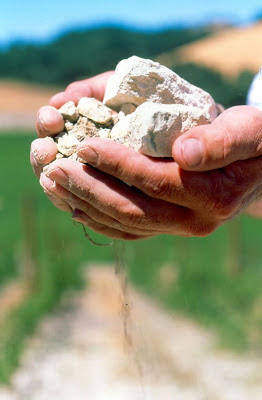Cabernet
Franc
Cabernet
Franc is one of the major black grape varieties worldwide. It is principally
grown for blending with Cabernet Sauvignon and Merlot in the Bordeaux style,
but can also be vinified alone - as in the Loire's Chinon.
Cabernet
Franc is lighter than Cabernet Sauvignon, making a bright pale red wine and
contributing finesse and a peppery perfume to blends with more robust grapes.
Depending on growing region and style of wine, additional aromas can include
tobacco, raspberry, bell pepper, and cassis, sometimes even violets.
DNA
analysis indicates Cabernet Franc is one of two parents of Cabernet Sauvignon,
a cross between it and Sauvignon Blanc.
Cabernet
Franc is believed to have been established in the Libournais region of
southwest France sometime in the 17th century when Cardinal Richelieu
transported cuttings of the vine to the Loire Valley.
Zinfandel
Zinfandel
is a variety of red grape planted in over 10 percent of California vineyards.
DNA fingerprinting revealed that it is genetically equivalent to the Croatian
grapes Crljenak Kaštelanski and as well as Tribidrag the Primitivo variety
traditionally grown in Puglia-the "heel" of Italy, where it was
introduced in the 18th century. The grape found its way to the United States in
the mid-19th century, and became known by variations of the name
"Zinfandel", a name of uncertain origin.
Zinfandel,
meaning the red wine, is known for its rich, dark color scheme, medium to high
tannin levels and a higher alcohol content. The Zinfandel feature flavors
include: raspberry, blackberry, cherry, plums, raisins, spice and blackpepper
all wrapped around various intensities of oak.
White
Zinfandel wine is made from the red Zinfandel grape, but the grape skins are
quickly removed after they are crushed so there is significantly less contact
time with the heavily pigmented red grape skin, resulting in a pink-rose
colored wine, instead of a deep red wine.
The
European Union recognized Zinfandel as a synonym for Primitivo in January 1999,
meaning that Italian Primitivos can be labelled as Zinfandel in the United
States and any other country that recognises EU labelling laws. Italian
winemakers have taken advantage of these rules and shipped Primitivo wines to
the United States labelled as Zinfandels.
Grenache
Noir
Grenache
or Garnacha (as it is known in Spain) most likely originated in the region of
Aragon in northern Spain, according to ampelographical evidence. Plantings
probably spread from the original birthplace to Catalonia and other lands under
the Crown of Aragon such as Sardinia and Rousillon in southern France.
Grenache,
(also known as Grenache Noir, to distinguish it from its white counterpart
Grenache Blanc) is the most widely planted grape in the southern Rhône Valley,
and the second most widely planted varietal in the world. It is most often
blended (with Syrah and Mourvèdre in France and Australia, and with Tempranillo
in Rioja), but is probably best known from the wines of Châteauneuf-du-Pape,
where it comprises 70% of the appellation’s acreage.
The
characteristic notes of Grenache are berry fruit such as raspberries and
strawberries. When yields are kept in check, Grenache-based wines can develop
complex and intense notes of blackcurrants, black cherries, black olives,
coffee, gingerbread, honey, leather, black pepper, tar, spices, and roasted
nuts.
Gewürztraminer
The
story starts with the ancient Traminer variety, a green-skinned grape that
takes its name from the village of Tramin, located in South Tyrol, the
German-speaking province in northern Italy.
Gewürztraminer
is one of the most pungent wine varietals, easy for even the beginning taster
to recognize by its heady, aromatic scent. Gewürztraminer is a variety with a
pink to red skin colour, which makes it a "white wine grape" as
opposed to the blue to black-skinned varieties commonly referred to as
"red wine grapes". The variety has high natural sugar and the wines
are white and usually off-dry, with a flamboyant bouquet of lychees.
Dry
Gewürztraminers may also have aromas of roses, passion fruit and floral notes.
It is not uncommon to notice some spritz-fine bubbles on the inside of the
glass. Gewürztraminer's sweetness may offset the spice in Asian cuisine. It
goes well with Hirtenkäse, Münster cheese, and fleshy, fatty (oily) wild game.
Smoked salmon is a particularly good match.
Pinot
blanc
Pinot
blanc is a white wine grape. It is a point genetic mutation of Pinot noir.
Pinot
blanc's name varies by region. In Austria it may be bottled as Weissburgunder
or Klevner (also occasionally named so in Alsace). Hungary calls it Fehér
Burgundi. Spain and Italy refer to it as Pinot bianco. In the Czech Republic it
is known as Rulandské Bilé, in Slovakia Rulandské Biele, and in Croatia Pinot
bijeli or Burgundac bijeli. In Serbia it is called Beli burgundac.
In
2000, there were 1,300 hectares of Pinot blanc in France, with most of the
plantations found in Alsace, where it is used for both still white wines and is
the most common variety used for sparkling wine, Crémant d'Alsace. The most
full-bodied "Pinot blanc" wines from Alsace, with a spicy and smokey
character and moderate acidity, are probably dominated by Auxerrois grapes.
Bottles
labeled Pinot Blanc offer fruity aromas, often of apple, citrus fruit, and
floral characteristics. Bottles that are varietally pure, although more
difficult to find, provide stronger floral characteristics, stone fruits and a
headier minerality. Regardless of their exact composition, most wines under the
label 'Pinot Blanc' are rather high in acidity and are vinified in tank, though
more prestigious examples are fermented in large, 100% used oak barrels. Pinot
blanc wines are usually made for immediate consumption and seldom meant for
cellaring.
Pinot
Gris
Pinot
gris, or Pinot grigio in Italy, is a variant of the Pinot noir (often blended
with Pinot noir to enrich and lighten the wine's flavor), with grape clusters
colored bluish gray, pink and brown. Often described as having a floral, smoky,
honey-tinged flavor with a minor citrus kick, Pinot gris wine is a dry, crisp
white wine often high in acidity and low in tannins. Pinot gris should be
consumed within two years of its vintage, and pairs well with seafood, pork and
chicken, if served sans acidic embellishments. Pinot gris' nomenclature varies
according to region of growth: Pinot grigio in Italy (and Tre Venezie,
specifically), Ruländer or Grauburgunder in Germany, Tokay d'Alsace, Pinot
beurot or Fromentau in France, and Sivi Pinot in Eastern Europe.
The
wines produced from this grape also vary in colour from a deep golden yellow to
copper and even a light shade of pink, and it is one of the more popular grapes
for orange wine.
A
major grape in Alsace, grown on 13.9% of the region's vineyard surface in 2006,
the varietal Pinot-gris d'Alsace is markedly different from Pinot gris found
elsewhere. The cool climate of Alsace and warm volcanic soils are particularly
well suited for Pinot gris, with its dry autumns allowing plenty of time for
the grapes to hang on the vines, often resulting in wines of very powerful
flavours. Pinot gris is considered an "early to market wine" that can
be bottled and out on the market within 4–12 weeks after fermentation.
Semillon
Semillon
is a golden-skinned grape used to make dry and sweet white wines, most notably
in France and Australia.
The
ripe semillon berry is a rich yellow color at maturity, although increasing sun
exposure may turn it amber-pink. In warmer climates, there is always danger of
sunburn and raisining. If processed as a dry or semidry table wine, the thin
skins and tender, juicy pulp require speedy but gentle handling to avoid
oxidation and browning.
Semillon
grapes make up 80% of the blend in the most expensive and famous dessert wine
in the world: Château d'Yquem. Semillon seems the favorite foil of Botrytis
Cinerea, the noble rot which concentrates the sugars and flavors and
intensifies the aromas for Yquem and the other "late-harvest" dessert
wines of France's Monbazillac and Sauternes appellations.
Wines
dominated by semillon may lack much youthful aroma, but have fairly full body
and tend to be low in acidity, even "oily" or "fat" at
times. Semillon also has an affinity for oak, accentuating subtleties such as
"toast" and "smoke" that emanate from wines'
"spice" rather than its "main ingredient", but nonetheless
adding complexity.
Chenin
Blanc
Chenin
blanc is a white wine grape variety from the Loire valley of France. Its high
acidity means it can be used to make everything from sparkling wines to
well-balanced dessert wines, although it can produce very bland, neutral wines
if the vine's natural vigor is not controlled. It is the most widely planted variety
in South Africa, where it is also known as Steen.
It
provides a fairly neutral palate for the expression of terroir, vintage
variation and the winemaker's treatment. In cool areas the juice is sweet but
high in acid with a full-bodied fruity palate.
Chenin
blanc is probably the world's most versatile grape, being able to produce
quality wines of various sweetness, including dessert wines noted for their
aging ability, as well as sparkling made according to the méthode champenoise
and fortified wines.
The
aromas and flavor notes of Chenin blanc often include the descriptors of
minerally, greengage, angelica and honey. Chenin wines produced from noble rot
will often have notes of peaches and honey that develop into barley sugar,
marzipan, and quince as they age. Dry or semi-sweet Chenin blanc from the Loire
will often have notes apple, greengage, and chalky minerals that develop into
more honey, acacia, and quince aromas. New World styles of Chenin, such as
those of South Africa, are more often made to be consume young and exhibit rich
tropical fruit notes such as banana, guava, pear, and pineapple. The alcohol
level for dessert styles Chenin rarely goes above 12%, which keeps the wines
more in balance. Drier styles of Chenin are more likely to be around 13.5%.


























